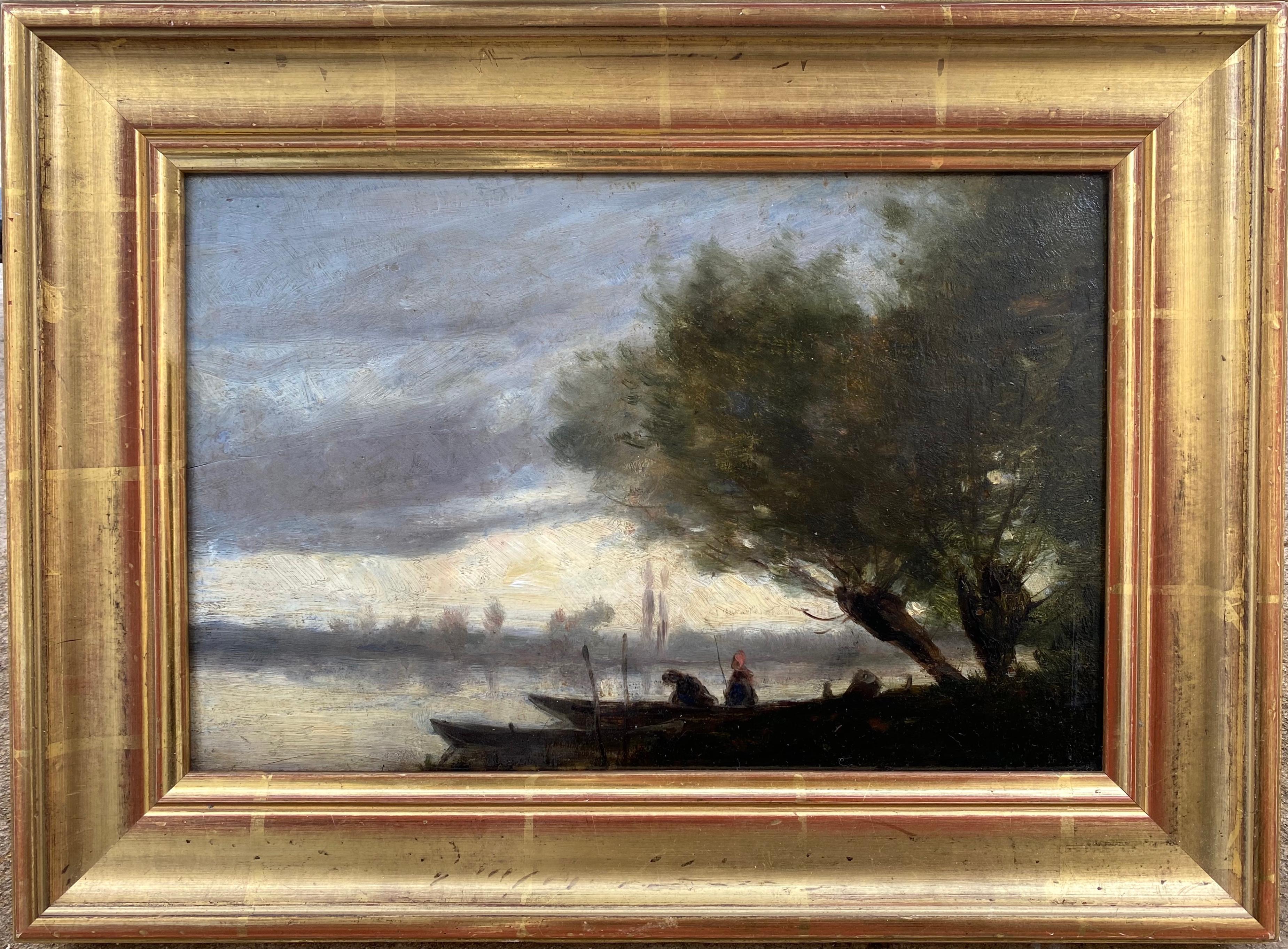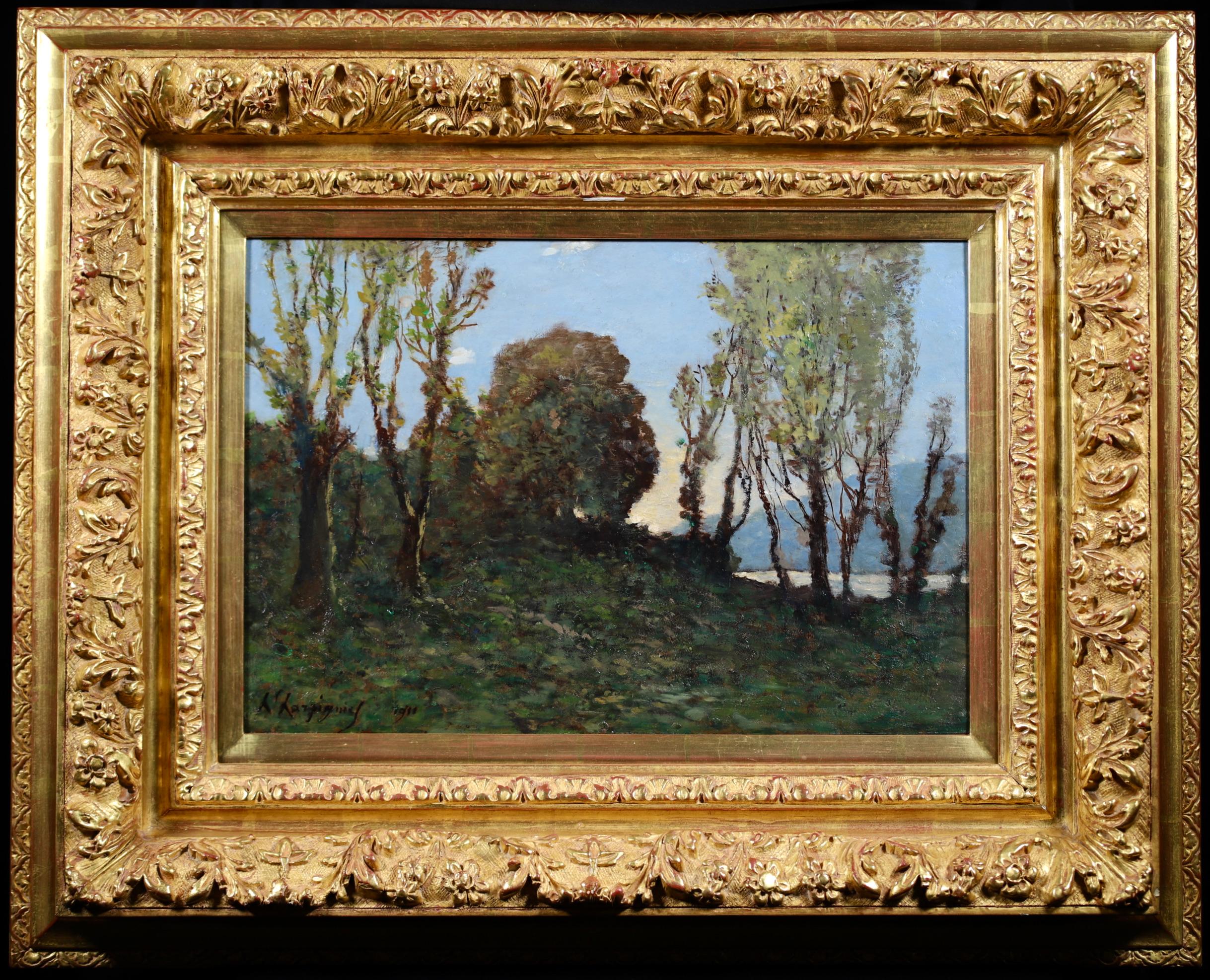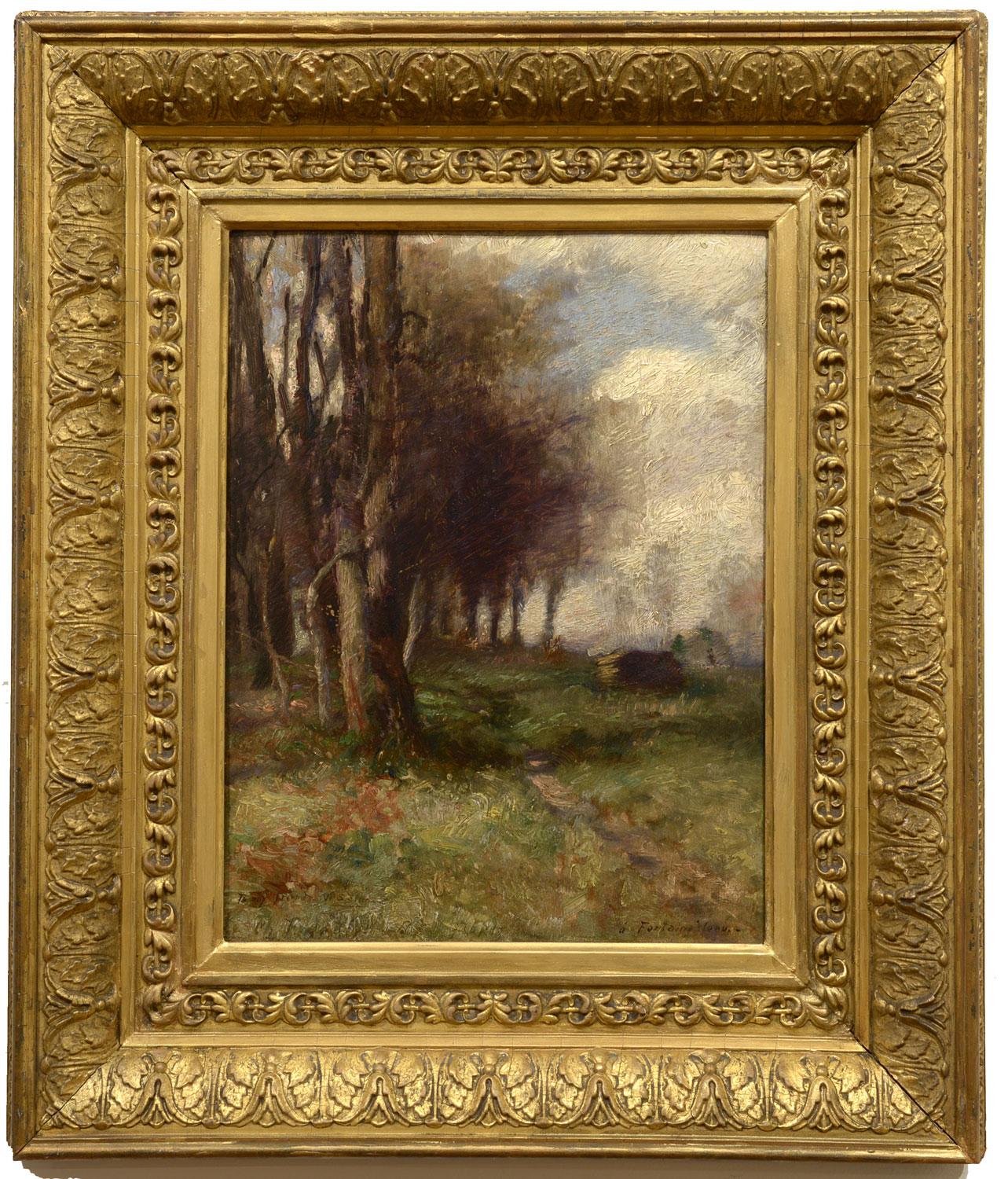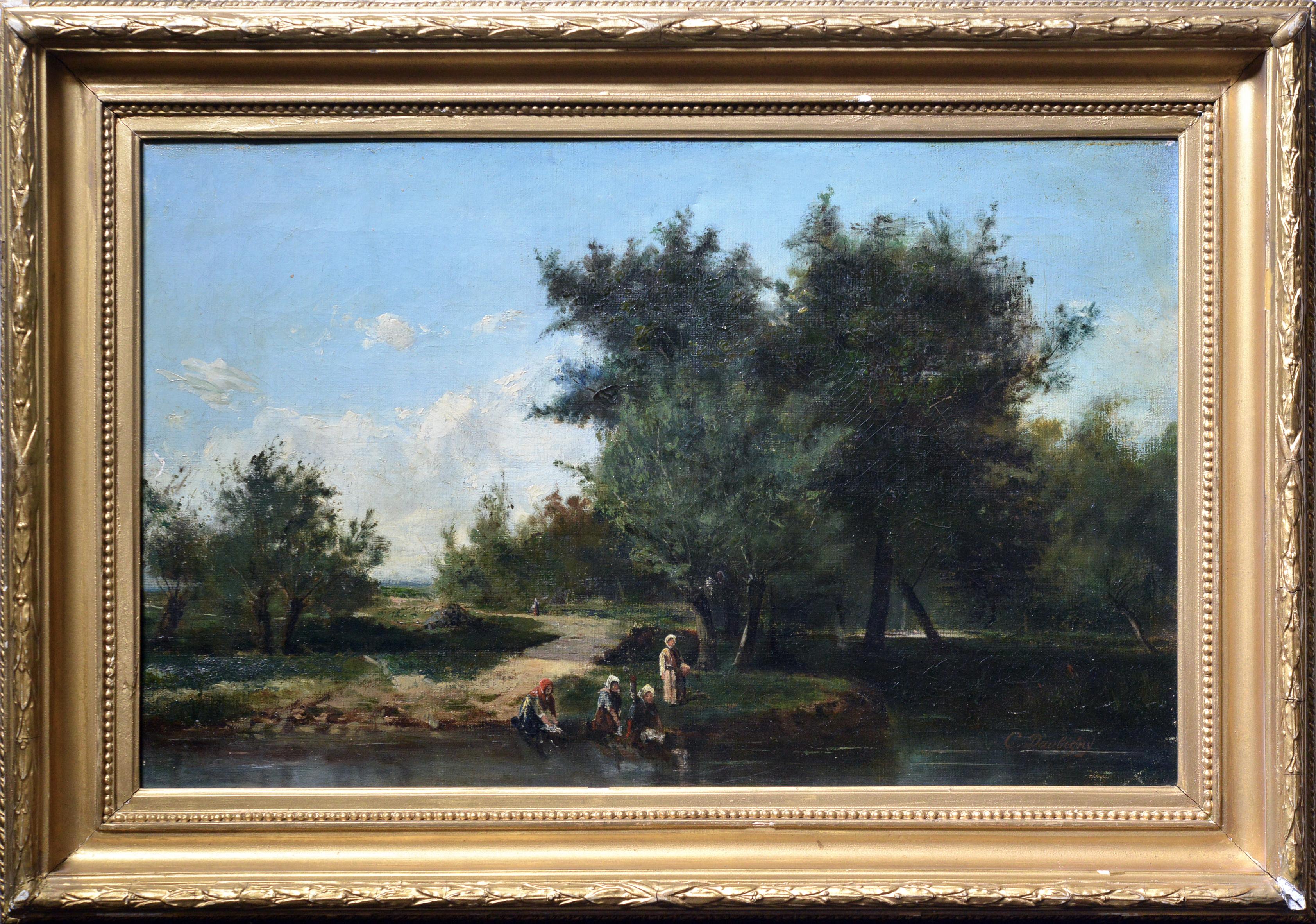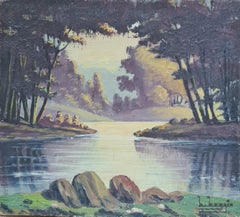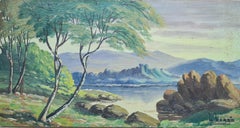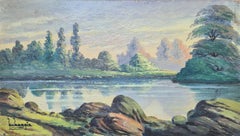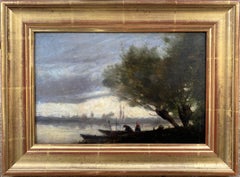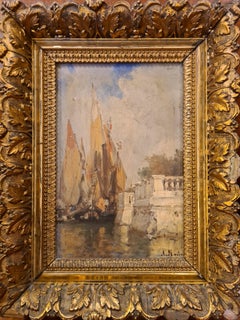
Le Jardin Française, The Balustrade, Venice
View Similar Items
Want more images or videos?
Request additional images or videos from the seller
1 of 22
Amédée RosierLe Jardin Française, The Balustrade, Venice1870's
1870's
About the Item
- Creator:Amédée Rosier (1831 - 1898, French)
- Creation Year:1870's
- Dimensions:Height: 13 in (33.02 cm)Width: 10 in (25.4 cm)Depth: 1.75 in (4.45 cm)
- Medium:
- Movement & Style:
- Period:
- Condition:
- Gallery Location:Cotignac, FR
- Reference Number:Seller: LG1stDibs: LU143027181142
About the Seller
5.0
Platinum Seller
These expertly vetted sellers are 1stDibs' most experienced sellers and are rated highest by our customers.
Established in 2000
1stDibs seller since 2020
165 sales on 1stDibs
Typical response time: 1 hour
More From This SellerView All
- Barbizon School Lakeside Landscape, The Shady Glen.Located in Cotignac, FRAn oil on panel idyllic landscape by Boggio. The painting is signed bottom right. An idealised lakeside landscape view of a shady glen in the style of the Barbizon school.Category
Mid-20th Century Barbizon School Landscape Paintings
MaterialsOil, Board
- Barbizon School Lakeside Landscape With CastleLocated in Cotignac, FRAn oil on panel idyllic landscape by Boggio. The painting is signed bottom right. An idealised lakeside landscape view with a castle in the distance in the style of the Barbizon sch...Category
Mid-20th Century Barbizon School Landscape Paintings
MaterialsOil, Board
- Barbizon Lakeside Landscape With Poplar Trees. Oil on Board.Located in Cotignac, FRAn oil on panel idyllic landscape by Boggio. The painting is signed bottom left. An idealised lakeside landscape view with poplar trees in the style of the Barbizon school.Category
Mid-20th Century Barbizon School Landscape Paintings
MaterialsOil, Board
- The Forest, Large Barbizon School, Oil on Canvas Wooded LandscapeBy Emile Roux-FabreLocated in Cotignac, FRA French Barbizon School oil on canvas forest view by Emile Roux-Fabre. The painting is signed and dated bottom left with a dedication. A charming view of forest glade leading out to a valley landscape beyond. The artist has captured the magic feeling of the cool forest shade against the sunshine of the landscape beyond. The texture of the bark on the silver birch trees, the contrast of the leaves on the trees all framing the perspective to the view beyond. An extremely accomplished and atmospheric painting. The Barbizon school of painters was part of an art movement towards Realism in art, which arose in the context of the dominant Romantic Movement of the time. The Barbizon school was active roughly from 1830 through 1870. It takes its name from the village of Barbizon, France, on the edge of the Forest of Fontainebleau, where many of the artists gathered. Most of their works were landscape paintings, but several of them also painted landscapes with farmworkers, and genre scenes of village life. Some of the most prominent features of this school are its tonal qualities, colour, loose brushwork, and softness of form. The leaders of the Barbizon school were: Théodore Rousseau, Charles-François Daubigny, Jules Dupré, Constant Troyon, Charles Jacque, and Narcisse Virgilio Díaz. Jean-François Millet lived in Barbizon from 1849, but his interest in figures with a landscape backdrop sets him rather apart from the others. Jean-Baptiste-Camille Corot was the earliest on the scene, first painting in the forest in 1829, but his work has a poetic and literary quality which sets him somewhat apart. Other artists associated with the school, often pupils of the main group, include: Henri Harpignies, Albert Charpin, François-Louis Français and Émile van Marcke. In 1824 the Salon de Paris exhibited works of John Constable, an English painter. His rural scenes influenced some of the younger artists of the time, moving them to abandon formalism and to draw inspiration directly from nature. Natural scenes became the subjects of their paintings rather than mere backdrops to dramatic events. During the Revolutions of 1848 artists gathered at Barbizon to follow Constable's ideas, making nature the subject of their paintings. The French landscape became a major theme of the Barbizon painters. Millet extended the idea from landscape to figures — peasant figures, scenes of peasant life, and work in the fields. In The Gleaners (1857), for example, Millet portrays three peasant women working at the harvest. Gleaners are poor people who are permitted to gather the remains after the owners of the field complete the main harvest. The owners (portrayed as wealthy) and their laborers are seen in the back of the painting. Millet shifted the focus and the subject matter from the rich and prominent to those at the bottom of the social ladders. To emphasize their anonymity and marginalized position, he hid their faces. The women's bowed bodies represent their everyday hard work. In the spring of 1829, Jean-Baptiste-Camille Corot came to Barbizon to paint in the Forest of Fontainebleau, he had first painted in the forest at Chailly in 1822. He returned to Barbizon in the autumn of 1830 and in the summer of 1831, where he made drawings and oil studies, from which he made a painting intended for the Salon of 1830; "View of the Forest of Fontainebleau'" (now in the National Gallery in Washington) and, for the salon of 1831, another "View of the Forest of Fontainebleau"'. While there he met the members of the Barbizon school: Théodore Rousseau, Paul Huet, Constant Troyon, Jean-François Millet, and the young Charles-François Daubigny. During the late 1860s, the Barbizon painters attracted the attention of a younger generation of French artists studying in Paris. Several of those artists visited Fontainebleau Forest to paint the landscape, including Claude Monet, Pierre-Auguste Renoir, Alfred Sisley and Frédéric Bazille. In the 1870s those artists, among others, developed the art movement called Impressionism and practiced 'plein air' painting. In contrast, the main members of the school made drawings and sketches on the spot, but painted back in their studios. The Post-Impressionist painter Vincent Van Gogh studied and copied several of the Barbizon painters as well, including 21 copies of paintings by Millet. He copied Millet more than any other artist. He also did three paintings in Daubigny's Garden. The Barbizon painters also had a profound impact on landscape painting in the United States. This included the development of the American Barbizon school by William Morris Hunt. Several artists who were also in, or contemporary to, the Hudson River School studied Barbizon paintings for their loose brushwork and emotional impact. A notable example is George Inness, who sought to emulate the works of Rousseau. Paintings from the Barbizon school also influenced landscape painting in California. The artist Percy Gray...Category
Early 20th Century Barbizon School Landscape Paintings
MaterialsCanvas, Oil
- The River Bridge, Barbizon School, Circle of Jean Baptiste Camille CorotLocated in Cotignac, FRA French Barbizon School oil on canvas view of an idylic landscape signed M Legrand de C. Signed bottom left and presented in fine gilt 'Regence' style frame. The painting is on a qu...Category
Mid-19th Century Barbizon School Landscape Paintings
MaterialsCanvas, Oil
- A Christmas Winter Wonderland, Barbizon School Snowscape.Located in Cotignac, FRAn oil on panel view of a winter snow scene by Boggio. The painting is signed bottom right. A charming view of a snow scene, a river running under a bridge heavy with snow. A Christ...Category
Mid-20th Century Barbizon School Landscape Paintings
MaterialsBoard, Oil
You May Also Like
- L'attenteBy Bernardus Johannes BlommersLocated in Barbizon, FRBLOOMERS "L’attente” Oil on panel. 30 x 26.5 cm. Signed lower right Son of a talented lithographer, he was initially destined for the same profession as his father. But at the Acade...Category
19th Century Barbizon School Landscape Paintings
MaterialsOil, Wood Panel
- Fishing by Moonlight manner of Corot: Mooonlit lake French Barbizon oil paintingBy Jean-Baptiste-Camille CorotLocated in Norwich, GBNobody quite does moonlight quite like Camille Corot. Moonlit landscapes suited the artist's discreet artist's personality and painting. As Baudelaire astutely observed: "M. Corot is...Category
1860s Barbizon School Landscape Paintings
MaterialsWood Panel, Oil
- Light on the water, luminous river landscape with two lone figures paintingBy Charles LapostoletLocated in Norwich, GBThere is a lot to see in this delicate, luminous landscape: a little fisherman, a figure in his canoe, and the beautiful light on the water. It is an ...Category
Mid-19th Century Barbizon School Landscape Paintings
MaterialsOil, Wood Panel
- Bords de riviere a Saint-Prive - Barbizon Landsape Oil - Henri Joseph HarpigniesBy Henri Joseph HarpigniesLocated in Marlow, BuckinghamshireSigned and dated Barbizon School landscape oil on panel by French painter Henri Joseph Harpignies. The work depicts the trees lining the banks of the River Loing at Saint Prive in no...Category
1910s Barbizon School Landscape Paintings
MaterialsOil, Panel
- "a Fontainebleu, " Charles Francis DeKlyn, Barbizon oil, French countrysideLocated in Wiscasset, MECharles Francis De Klyn was born in Westchester County, New York, in 1865. A landscape, marine, portrait and figure painter, De Klyn studied in New York and Paris from 1886 to 1891, then taught at the Cleveland Art Club and the Cleveland School of Art. In 1893, he was one of the founders of the Cleveland Brush and Palette Club, and he exhibited at the National Academy of Design in 1894 and 1895. He was also a member of the Society of Western Artists. "A Fontainebleu" by Charles Francis De Klyn is a beautifully rendered Barbizon oil...Category
Late 19th Century Barbizon School Landscape Paintings
MaterialsOil, Panel
- Sunset, an emblematic painting by Théodore Rousseau inspired by BarbizonBy Théodore RousseauLocated in PARIS, FRWhile an exhibition is currently celebrating the work of Théodore Rousseau at the Petit-Palais in Paris, we are delighted to present this work, which is entirely emblematic of his ar...Category
Mid-19th Century Barbizon School Landscape Paintings
MaterialsMahogany, Oil
Recently Viewed
View AllMore Ways To Browse
19th Century Landscape Moonlight
Naval Battles Oil Painting
Naval Battle Oil
1870s Painting On Wood
Constantinople Painting
Carolus Duran
Leon Cogniet
Oil Painting Constantinople
Painting French Naval Battle
Pauly Venice
Ziem Felix
Constantinople Landscape Painting
1950s Retro Beach Art
Boston State House
Lake Oil Painting 19th Century
Rustic Vintage Wood Signs
Beach Sunset Paintings
Beach Sunset Painting

